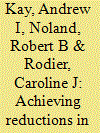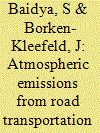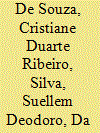|
|
|
Sort Order |
|
|
|
Items / Page
|
|
|
|
|
|
|
| Srl | Item |
| 1 |
ID:
132687


|
|
|
|
|
| Publication |
2014.
|
| Summary/Abstract |
It is well established that GHG emissions must be reduced 50 to 80% by 2050 in order to limit global temperature increase to 2 °C. Achieving reductions of this magnitude in the transportation sector is a challenge and requires a multitude of policies and technology options. The research presented here analyzes three scenarios: changes in the perceived price of travel, land use intensification, and increases in transit. Elasticity estimates are derived using an activity-based travel model for the state of California and broadly representative of the US. The VISION model is used to forecast changes in technology and fuel options that are currently forecast to occur in the US for the period 2000-2040, providing a life-cycle GHG forecast for the road transportation sector. Results suggest that aggressive policy action is required, especially pricing policies, but also more on the technology side, especially increases in the carbon efficiency of medium and heavy-duty vehicles.
|
|
|
|
|
|
|
|
|
|
|
|
|
|
|
|
| 2 |
ID:
091526


|
|
|
|
|
| Publication |
2009.
|
| Summary/Abstract |
India has become one of the biggest emitters of atmospheric pollutants from the road transportation sector globally. Here we present an up-to-date inventory of the exhaust emissions of ten species. This inventory has been calculated bottom-up from the vehicle mileage, differentiating by seven vehicle categories, four age/technology layers and three fuel types each, for the seven biggest cities as well as for the whole nation. The age composition of the rolling fleet has been carefully modelled, deducting about one quarter of vehicles still registered but actually out-of-service. The vehicle mileage is calibrated to the national fuel consumption which is essential to limit uncertainties. Sensitivity analyses reveal the primary impact of the emission factors and the secondary influence of vehicle mileage and stock composition on total emissions. Emission estimates since 1980 are reviewed and qualified. A more comprehensive inspection and maintenance is essential to limit pollutant emissions; this must properly include commercial vehicles. They are also the most important vehicle category to address when fuel consumption and CO2 emissions shall be contained.
|
|
|
|
|
|
|
|
|
|
|
|
|
|
|
|
| 3 |
ID:
088989


|
|
|
|
|
| Publication |
2009.
|
| Summary/Abstract |
This article documents and analyzes the changes in fuel efficiency of vehicles on US roads between 1923 and 2006. Information about distances driven and fuel consumed was used to calculate the on-the-road fuel efficiency of the overall fleet and of different classes of vehicles. The overall fleet fuel efficiency decreased from 14 mpg in 1923 to 11.9 mpg in 1973. Starting in 1974, efficiency increased rapidly to 16.9 mpg in 1991. Thereafter, improvements have been small, with efficiency reaching 17.2 mpg in 2006. The information for 2006 was used to calculate the fuel-efficiency improvements in different classes of vehicles that would be needed to achieve a given percentage reduction in the total amount of fuel consumed by all vehicles.
|
|
|
|
|
|
|
|
|
|
|
|
|
|
|
|
| 4 |
ID:
117313


|
|
|
|
|
| Publication |
2013.
|
| Summary/Abstract |
Road transportation has contributed to increased emissions of conventional air pollutants and, consequently, to the increase in problems associated with the environment and human health, depending on the type of pollutant and the concentration of it. To support the development of public policies aimed to decrease total tonnes of emissions, we used a bottom-up approach to estimate the amount of air pollutants, such as carbon monoxide (CO), total hydrocarbons (THC), nitrogen oxides (NOx), particulate matter (PM), and aldehydes (RCHO), that are emitted by road transportation in the state of Rio de Janeiro (RJ) from 1980 to 2010. The results from 2010 show that cars are responsible for 55% of CO emissions, 61% of THC emissions, and 93% of RCHO emissions. Due to the use of hydrated ethanol and compressed natural gas (CNG) instead of petroleum based fuels during the period analyzed, 1,760,370 t of air pollutant emissions were avoided. Compared to Brazil, in 2010, RJ had a quantity of emissions per vehicle from 12% (CO) to 59% (PM) smaller than the national average. As strategies to reduce air pollutant emissions, we consider reducing the intensity of use, with a proportional reduction in emissions, and increased the use of biodiesel.
|
|
|
|
|
|
|
|
|
|
|
|
|
|
|
|
|
|
|
|
|